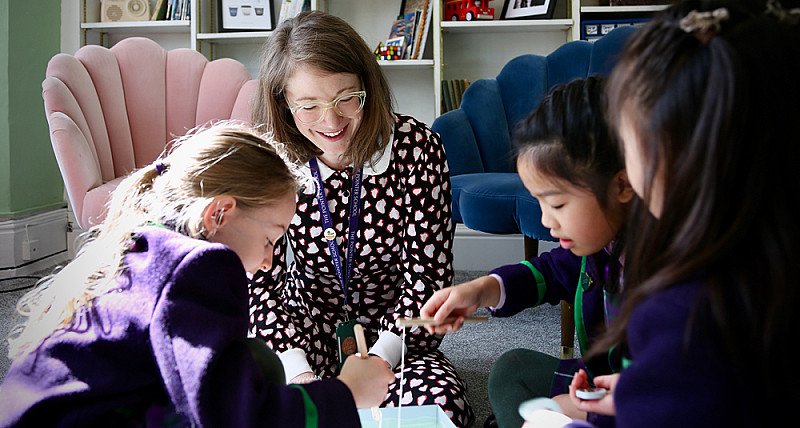- 0208 293 1331Call us
- office@pointers-school.co.uk Email us

By Charlotte Crookes, Head
Almost 200 years ago the Danish philosopher Soren Kierkegaard wrote about the idea of the “leap of faith”, the act of believing in something outside of the boundaries of reason. Kierkegaard was writing about the Christian religion but this is something that rational adults who subscribe to any world faith must wrestle with on an almost daily basis. So as teachers within a faith school, how do we encourage our pupils to start to take that leap of faith, and discover their own spirituality? Piaget noted that young children have an exceptionally vivid imagination: for them, anything is possible. Their ideas about the world are not logical in the adult sense of logic. At this age, no ‘leap’ is needed for faith - children (particularly those in the Early Years) are open to ideas that we as adults struggle to understand, from the magical to the spiritual.
For most primary school children their initial exposure to and understanding of faith comes through stories. Children of this age love stories - my happiest memories of teaching throughout the primary age range come from moments of shared emotion while discovering a new story together. The most treasured age-old stories for children are usually those in which good triumphs over evil against all the odds - think of the tiny David versus the giant Goliath, or indeed many popular fairytales, from the defeat of the troll in the three billy goats gruff to the victory of little red riding hood over the big bad wolf. It’s incredible (even unbelievable) as an adult that such victories could occur, yet young children accept these incredible stories as truth without so much as a qualm. Frankly, in terms of engaging and enthusing children about faith, the more astounding and unbelievable the story from an adult perspective, the better. One only has to sit in on a Bible Assembly and see the gasps of delight from the youngest children when Jesus manages to feed an entire crowd from five loaves and two fish, to see that for children, the improbability and implausibility forms a core part of the appeal of such stories.
For our Primary-aged children, these stories are not only possible but plausible. Their belief is often as certain as their grasp of the alphabet, and they accept stories told to them by trusted adults as truth willingly. This doesn’t mean that they don’t have questions though! Anyone who has spent time with a Nursery or Reception class will know that young children have an uncanny ability to get to the root of a problem and ask the most unnerving and unanswerable questions! For us at Pointers, the teaching of faith and spirituality is all about giving children a safe space to ask these difficult questions. And it all begins with a story….
Throughout the school we use stories from the Bible as the basis for our teaching of the Christian faith. It’s not about the rote learning of scripture; rather, the purpose of telling these stories is to provide a starting point for children to discover more about their religion, and their faith. With our very youngest pupils we use the Godly Play scheme, where each week teachers ‘act out’ a story from the Bible, using a range of props and visual aids (usually these are felt backgrounds, symbols and figures, which are moved around a felt board). This is playful learning - children are encouraged to help out, take part in the stories, and then to reenact these in their own play. The stories are non-coercive (we don’t phrase them as “the truth” but rather as “what Christians believe”). The focus here is on exploring and discovering together. After each story, teachers ask the pupils a range of “I wonder….” questions for class discussion: I wonder if God was pleased with the things he created? I wonder why God created the night and the day? I wonder which day of the creation was the most important? The very phrasing of this question as “I wonder” rather than a more typical pedagogical “how”, “what” or “why” is key. It is an important signifier to our pupils that the teachers don’t hold all the answers here. The teacher guides the conversation, but is themselves ‘wondering’ along with their class. This creates a safe space for pupils to ask questions, even those that may have no easy answer (“what happens to us when we die?” “How is God everywhere?” “Why does God let bad things happen to good people?”). Pupils are encouraged to think about how people in the story feels, and to take meaning from the stories that can be used in their own lives about how to treat other people.
Older pupils obviously have a much more complex relationship with their faith. Pupils in our upper school are encouraged to continue to make use of the skills that they have encountered through Godly Play to fill out weekly reflection journals, and we encourage them to continue to ask the unanswerable questions. Faith for children at this stage is to be discovered through experience, with prayer, collective worship Assemblies and formal lessons about world religions enabling children to deepen their understanding of their own and others’ faiths. For us at Pointers, each half term begins and ends with an exuberant collective worship, where our entire school community gets together to sing songs of celebration, led by our wonderful Head of RE. On occasions like this, witnessing a Church full of children on their feet enthusiastically dancing and singing songs of worship and praise, even as a cynical adult the leap of faith doesn’t seem like such a big jump.